How do I build my own aero-cloner with
misters?
| Added by:
administrator Viewed: 415
times |
Rated by 20 users:
8.42/10 |
 |
|
Materials
List:
1 opaque plastic tub
1 Rio
800 water powerhead
10 foot length PVC,
1/2-inch
8 slip-coupling PVC elbows (90 degree
turns)
1 slip-coupling / threaded PVC
T-adapter
1 threaded hose nozzle
8 180
degree jet sprayers (part 111B)
4 PVC to
poly-tube adapters
2 feet flexible hose
1
roll 1/2-inch black poly-tubing
1 can white
spray paint or coating |
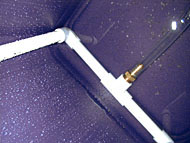 |
|
Every component
to make this aeroponic tub is available at your
local Home dePot,Wal-Mart, and aquarium store. You
could probably get it all from the dePot, but they
don't have the greatest selection of tubs.
You can use a different pump and skip the
aquarium store, but the Rio is a good choice @ 211
gph. It comes with a ball valve to control the
flow and the 800 uses a ceramic impeller so it
won't degrade in saltwater.
The only
problematic component in this design is the grade
of misters easily available. A few different
configurations were tried, and the barbed misters
screwed into semi-flexible poly-tubing seemed to
give the best results. All of these components are
located near the plumbing and PVC in a section for
sprinklers and drip irrigation, the brand is "DIG
Corporation." If easily available, you can use
better misters from a grow store. |
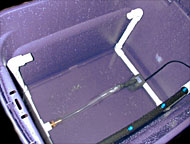 |
|
Cut the PVC to
necessary lengths. The most important factor is
the height of the assembly, so don't cut it too
short. You can always lower it afterwards. The 8
elbows connect the sides, and the T is inserted
opposite the pump. The T-adapter has one threaded
connection for the hose nozzle.
After
completing the PVC work, the next step is making
the spraybars. These are the black tubes that hold
the misters, it is a somewhat stiff poly tubing
sold for use with the emitters. This is where your
clogs will happen so be prepared-- have extra
misters on hand and you can even build two extra
spray bars that you can swap in while you clean
the others. |
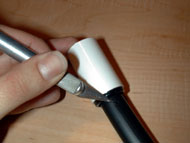 |
|
The spraybar
starts with a PVC to Poly tube adapter (sold with
all the other DIG accessories) and a length of the
tubing. Next make very small guide holes for the
misters to go into the tubing. It is very
important for the holes to be small, it should be
difficult to push the emitter into the tube. If
the fit is not secure, the emitter will not spray.
You may have to make a few spraybars before you
get it right.
Your worst enemy will be
clogs. Either you can replace the mister or the
entire spraybar. This is the biggest disadvantage
of aeroponics, but running distilled water for
cloning will keep clogs to a minimum. If you clean
it out it between cloning sessions it should
hardly clog at all. |
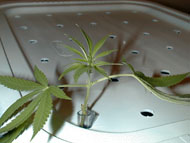 |
|
After you get
the spraybars right, install them in the system
and turn it on. You should get fountains of small
droplets splashing up, not really a mist from
these emitters, but it is still a very good
cloning environment.
All thats left after
that is to finish the top. Sold near the spray
paint is a white rubber coating that lasts much
better. This takes at least two or three coats for
a good reflective surface. Be sure and drill the
holes first or you will ruin the finish. Also cut
a notch for the power cord so the top closes
completely.
To hold the clones in you can
use pieces of tubing, pre-split down the middle.
You can easily remove these tubes and the clone
without damaging the root system. They need to be
transplanted quickly when they root or they will
become accustomed to the aeroponics and have a
more difficult time leaving. If transplanting into
soil or soilless mix you can even move them as
soon as they show bumps, around 5 days, and they
will root with no transplant shock in around a
week. |
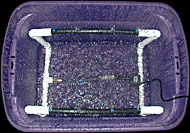 |
|
The quality of
water that you put in the tub has a direct
relationship to how fast the cuts will root. The
best water to start with is either distilled or
reverse-osmosis. They should both be between 0 and
20 parts per million and between 6.5 and 7.0 pH.
Using tap water will clog the emitters much more
quickly with mineral deposits. No rooting hormone
is needed.
Some people report good results
by using a watering schedule of 1/2 hour on, 1/2
hour off, but leaving the pump on constantly has
always produced quick rooting as well. The water
is super-saturated with oxygen from the constant
splashing and spraying. If the ambient temperature
isn't high enough, a necessary piece of equipment
is an aquarium heater set at 78 degrees.
I
hope you find this tub and aeroponic rooting
method to be the simplest and most effective
technique around. You simply fill the tub with
clean water, take a cut, and drop it in. 7 days
later you have roots-- no chemicals, no rockwool,
no mess. |
|
| Last modified: 08:42 - Feb 25,
2001 |
| |